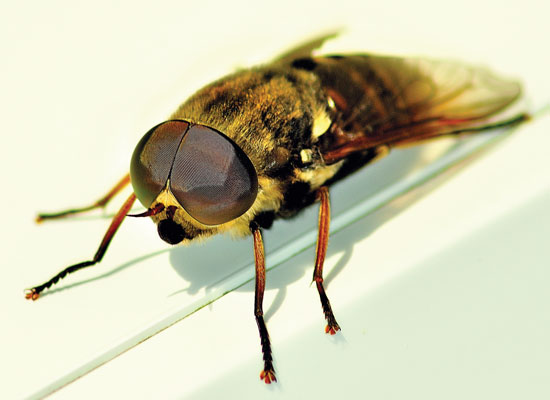
Photo: mrbackskin / iStock / Getty Images Plus / Getty Images
Horse flies and deer flies are pests of both domestic and wild animals — and occasionally of humans. Approximately 335 species occur in North America, while there are about 4,300 species worldwide. Adults range in size from small deer flies (about 0.25 inch in length) to large horse flies (about 1.25 inches in length). An extension bulletin from Purdue University states they are “robust flies with a pair of huge eyes known as ‘compound eyes.’ Those of some horse flies have colorful purple or green bands against a blue or yellowish-green background. The mouthparts are large and prominent, projecting downward and forward in front of the head. They have large, fan-shaped wings and are capable of rapid flight and flying long distances.”
Eggs of most tabanid flies, or tabanids, are deposited in masses on vegetation overhanging water or moist areas. Newly hatched larvae fall to the water or mud, where they feed on organic debris or prey on other aquatic life.
When ready to pupate, they migrate to drier areas of the soil. The entire life cycle may take two years or more to complete, depending on the species and environmental conditions.
Only female tabanids feed on blood. The Purdue bulletin reports “their mouthparts include two pairs of cutting ‘blades’ that lacerate skin and cause flow of blood out of the wound, which females lap up with a sponge-like mouthpart” — leading to painful bites. Males, meanwhile, feed on nectar, honeydew or other liquids.
Tabanids are strong, robust fliers that can be a considerable nuisance in recreational areas. A bulletin from the University of Florida notes that tabanids tend to “lie in wait in shady areas under bushes and trees for a host to happen by. Sight is the main host finding mechanism, but carbon dioxide and odor also play a role. Moving objects, especially if dark in color, are most prone to attack. Attacks occur during daylight hours with a peak beginning at sunrise and lasting three hours.
A second peak is two hours before sunset and commences shortly after.” The bulletin also notes that attack frequency is low on overcast days or at temperatures below 71 degrees Fahrenheit and above 89 degrees Fahrenheit.
Entomologists tend to agree that currently, managing tabanid populations is no easy task. Traps can be effective in small-scale areas such as yards, campsites and swimming pools. Cultural controls such as removing woody plants from residential areas and draining wet areas can curtail populations. Technicians and employees alike can protect themselves by wearing thick, long-sleeved shirts and thick pants, and a protective hat in tabanid-prone areas.
In the western U.S., deer flies have been implicated in mechanically transmitting the rare, but dangerous disease tularemia — a bacterial disease of rabbits and certain rodents that can be transmitted to humans. Tularemia also is known as deer fly fever or rabbit fever.
REFERENCES
- Entnemdept.ufl.edu/creatures/livestock/deer_fly.htm, accessed March 2024
- Extension.entm.purdue.edu/publichealth/insects/tabanid.html, accessed March 2024
- Truman’s Scientific Guide to Pest Management Operations, Seventh Edition, available for purchase at MyPMP.net/shop
Leave A Comment